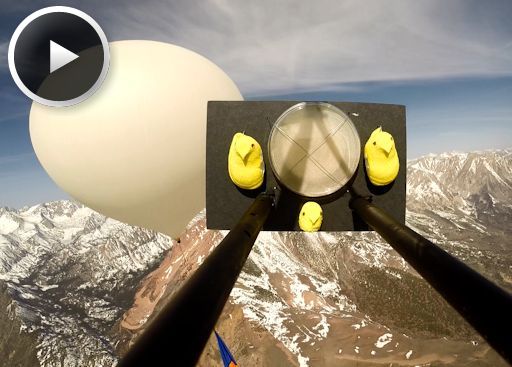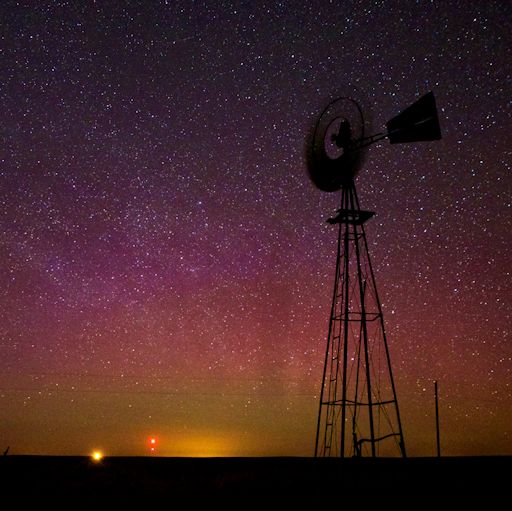When is the best time to see auroras? Where is the best place to go? And how do you photograph them? These questions and more are answered in a new book, Northern Lights - a Guide, by Pal Brekke & Fredrik Broms. | | | LYRID METEOR SHOWER: Earth is approaching a stream of debris from ancient Comet Thatcher, source of the annual Lyrid Meteor Shower. Usually the shower is mild (10-20 meteors per hour) but unmapped filaments of dust in the comet's tail sometimes trigger outbursts ten times stronger. Forecasters expect this year's peak, however strong it may be, to occur on April 22nd. [meteor gallery] PEEP-O-NAUTS TAKE RISKY TRIP TO THE EDGE OF SPACE: Yesterday, the students of Earth to Sky Calculus launched a pair of suborbital helium balloons to the stratosphere. One payload carried a radiation sensor to measure the effects of the Easter geomagnetic storm on Earth's upper atmosphere. The other payload carried a colony of halobacteria in an experiment to find out if the extremophiles could live at the edge of space. In honor of the holiday, the students launched some peeps as halobacteria companions. As this movie shows, it's risky being a peep-o-naut: 
The near-miss only 2000 ft. above the launch site almost brought an explosive end to the mission. Fortunately, the two balloons carried on to the stratosphere, gathering data on the solar storm in progress during the flight. Here is what peeps look like at the edge of space. Later, the peeps and halobacteria parachuted to Earth, landing in a tree in the Inyo Mountains of central California. Student adventurers recovered the payload and they are studying the data now. Realtime Space Weather Photo Gallery GEOMAGNETIC UNREST: As predicted, a CME struck Earth's magnetic field on Easter Sundy. Gusty solar wind conditions in the CME's wake are sparking auroras around the Arctic Circle. Last night, Northern Lights descended as far south as Isabel, South Dakota: 
"The aurora grew and sent pulsing pillars across the northern sky above Isabel Lake," says photographer Christian Begeman. "The show only lasted about 10 to 15 minutes. Just 45 minutes later, there was only a faint coloring in the sky." Meanwhile in the southern hemisphere, the aurora australis reached as far north as Yallingup, Australia. "It was amazing to witness such a rare display from Western Australia!" says photographer Steve Brooks. NOAA forecasters estimate a 60% chance of geomagnetic activity on April 21st as the solar wind continues to blow. High-latitude sky watchers should remain alert for auroras Aurora alerts: text, voice Realtime Aurora Photo Gallery
Realtime Eclipse Photo Gallery
Realtime Mars Photo Gallery
Realtime Comet Photo Gallery
Every night, a network of NASA all-sky cameras scans the skies above the United States for meteoritic fireballs. Automated software maintained by NASA's Meteoroid Environment Office calculates their orbits, velocity, penetration depth in Earth's atmosphere and many other characteristics. Daily results are presented here on Spaceweather.com. On Apr. 20, 2014, the network reported 9 fireballs.
(8 sporadics, 1 April Lyrid) 
In this diagram of the inner solar system, all of the fireball orbits intersect at a single point--Earth. The orbits are color-coded by velocity, from slow (red) to fast (blue). [Larger image] [movies]
Potentially Hazardous Asteroids ( PHAs) are space rocks larger than approximately 100m that can come closer to Earth than 0.05 AU. None of the known PHAs is on a collision course with our planet, although astronomers are finding new ones all the time. On April 21, 2014 there were 1465 potentially hazardous asteroids. Notes: LD means "Lunar Distance." 1 LD = 384,401 km, the distance between Earth and the Moon. 1 LD also equals 0.00256 AU. MAG is the visual magnitude of the asteroid on the date of closest approach. | | The official U.S. government space weather bureau | | | The first place to look for information about sundogs, pillars, rainbows and related phenomena. | | | Researchers call it a "Hubble for the sun." SDO is the most advanced solar observatory ever. | | | 3D views of the sun from NASA's Solar and Terrestrial Relations Observatory | | | Realtime and archival images of the Sun from SOHO. | | | from the NOAA Space Environment Center | | | the underlying science of space weather | | 
